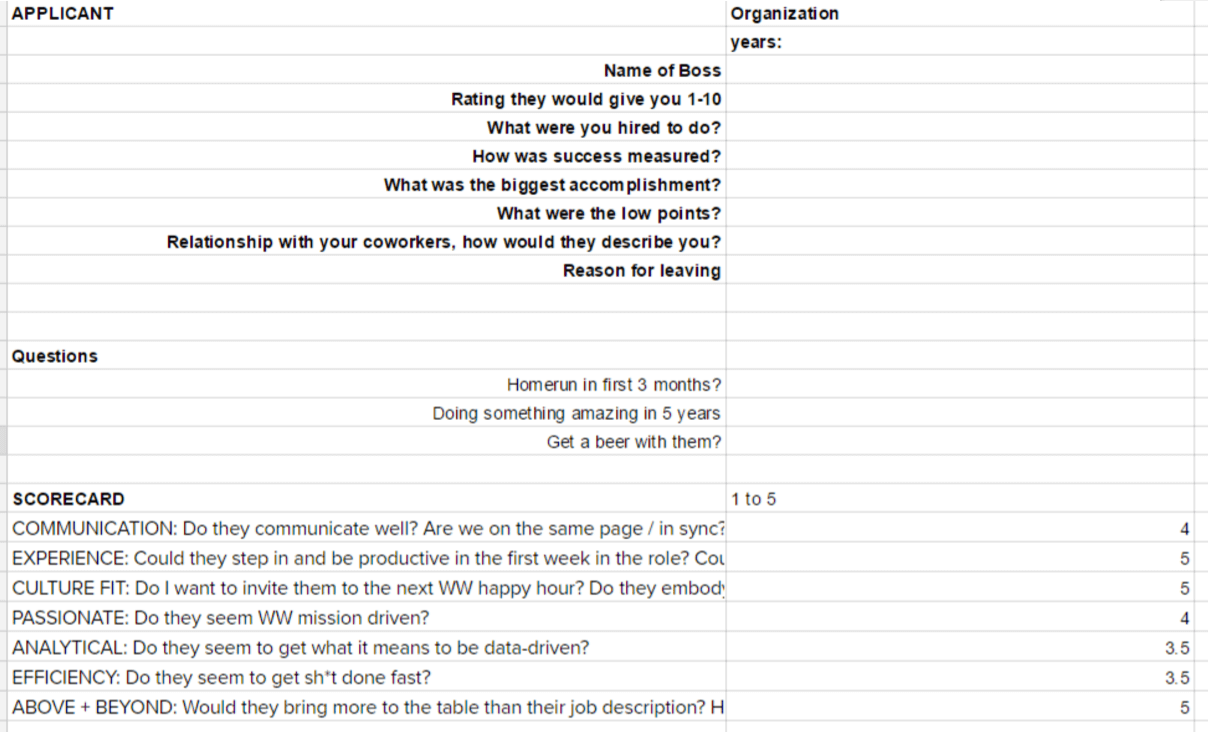You have found your talent, and now have potential candidates for your job. Time for the interview…where do we start?
Pro Tip: Use a Google Spreadsheet
The Google Spreadsheet can be your best friend when you are trying to make sure that you ask consistent questions throughout the entire process. In our experience, we have asked a multitude of questions while hinting at our scorecard questions, and ranked them one through five on their answers. Below is an example a Google Spreadsheet that may help you, but feel free to add any other questions that you find applicable:

Stage 1: The Screening Call (01:06)
In this stage, conduct 20-30 minute interviews with potential candidates with the CEO or the person who may most likely be their manager. Remember, you do not need to call everyone. It is a simple call, that can be done through Skype or on the phone, that gives you a sense of who they are and hints at your scorecard questions. Always make sure to ask if they are eligible to work in the US, and if they are able to perform all job functions without reasonable accommodations. Keep it short! If they seem do not seem like a fit, end early. However, if they do seem to fit, move on to the next round.
Stage 2: The Project (01:32)
For the project stage, give the candidate a project to show their experience in their prospective job function. Make it something that they would potentially be doing in their new role, and also, make sure that the same project is used for all candidates in the given job role so that it is fair.
Stage 3: Top Grading Interview (02:02)
“Top Grading” is a process outlined in the book, “Who”, where the goal is to ask 5 consistent questions of EVERY past job the applicant has on their resume. The goal is to have an honest look at the person’s work history and behavior pattern. This interview will be much longer than the previous interview and may last from an hour and a half to two and a half hours, depending on how long the candidate’s work history is. Ask questions such as who was your boss and how would they have rated you? The questions for each job is listed below, and feel free to use “what/how/tell me more” to get fuller answers in unclear areas:
- What were you hired to do?
- Who were the people you worked with? How was your relationship with them?
- What were the high points or wins of the job? How did those successes compare to previous year performance? How did it compare to the plan you had? How did it compare to your peers?
- What were the low points of the job?
- Why did you leave? (Determine if they were pushed out or pulled out by a better opportunity.
Stage 4: Scorecard Drilldown (04:52)
For full time hires, allow other full timers to have the opportunity to meet the candidate before an offer is extended.Usually, this can be structured in a “speed interview” style with the short 15-minute meetings or a group interview. These interviews will be focused on different areas of your scorecard, asking questions that get at the values and attributes of the position. With this process, the team can avoid being redundant and avoid getting the same answers. This also gives the other whalers a chance to assign hands-on work, to see how the candidate learns on the fly.
Tip: In this interview, look for passion and purpose alignment to make sure that you are all on the same page.
Don’t forget to…
Contact References
Make sure to contact references, regardless of how perfect the person may seem for the job! Remember to ask for strengths, areas of improvement, reason for leaving, advice to next manager.
Sell the Job
Make sure to sell the job because it is likely that if you are looking at A+ talent, then that person is also being considered in many different jobs. Don’t lose your talent!
And…Decision Time!
When deciding, make sure that team has a say in who gets hired because they are the ones who will be working with them. One bad member can really poison a team! Also, even after you decide, allow a 2-3 month trial period for the hire to make sure that they are a good match. During that process, the interview process can still be going on to ensure that you get the best talent that you possibly can.
We wish you the best of luck in your hiring endeavors! If you missed the first half of the recruitment process, be sure to check out our previous article.

